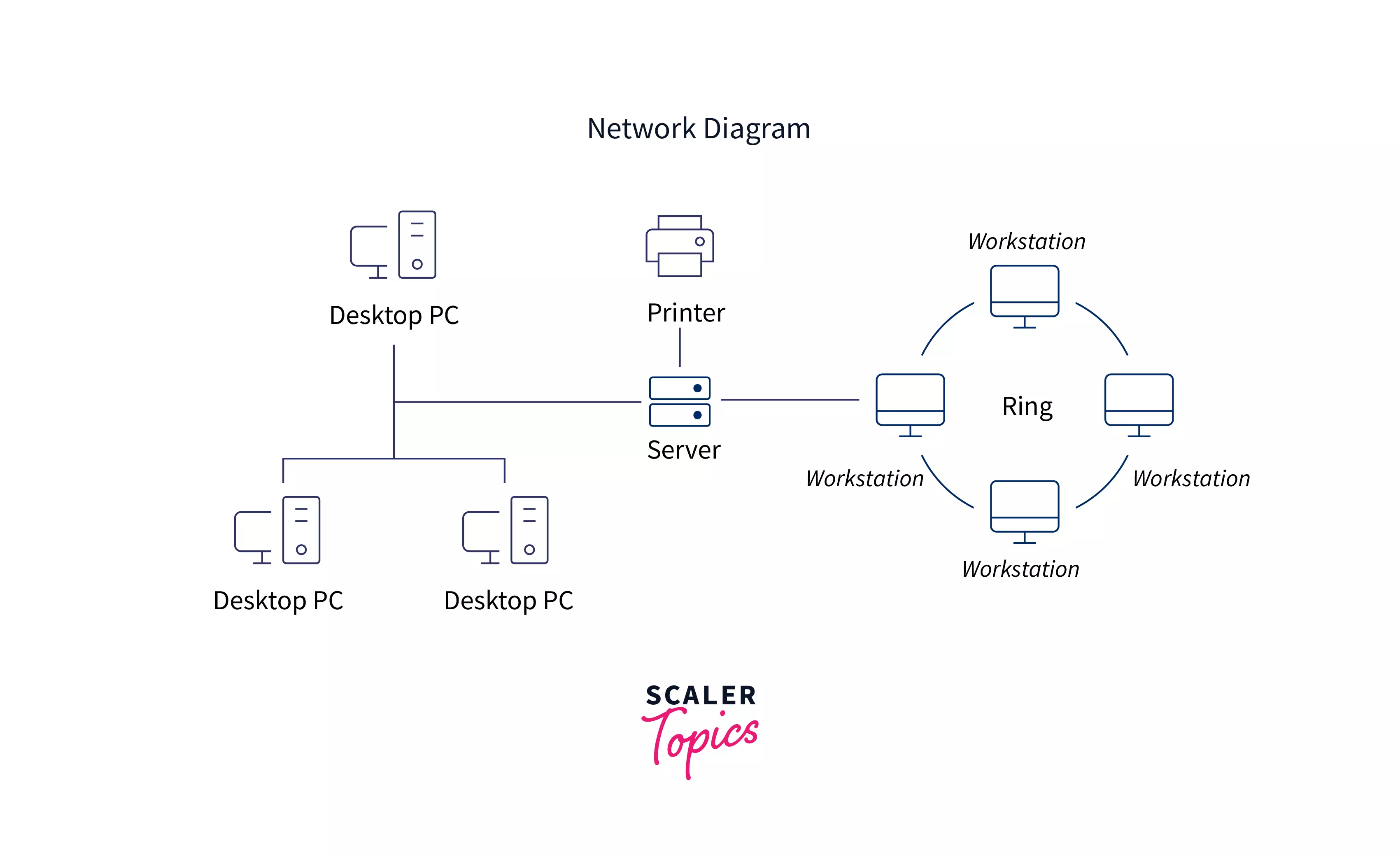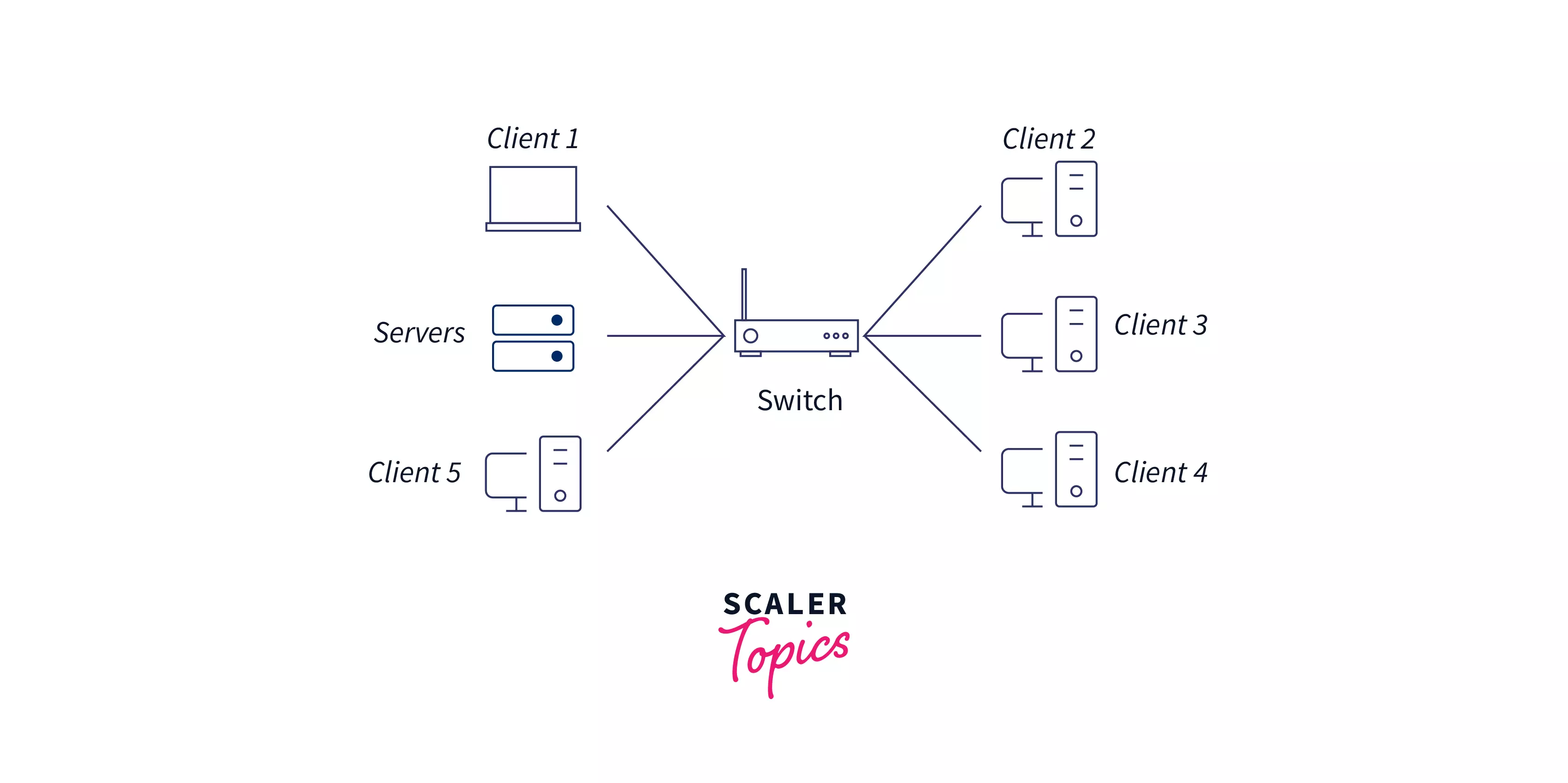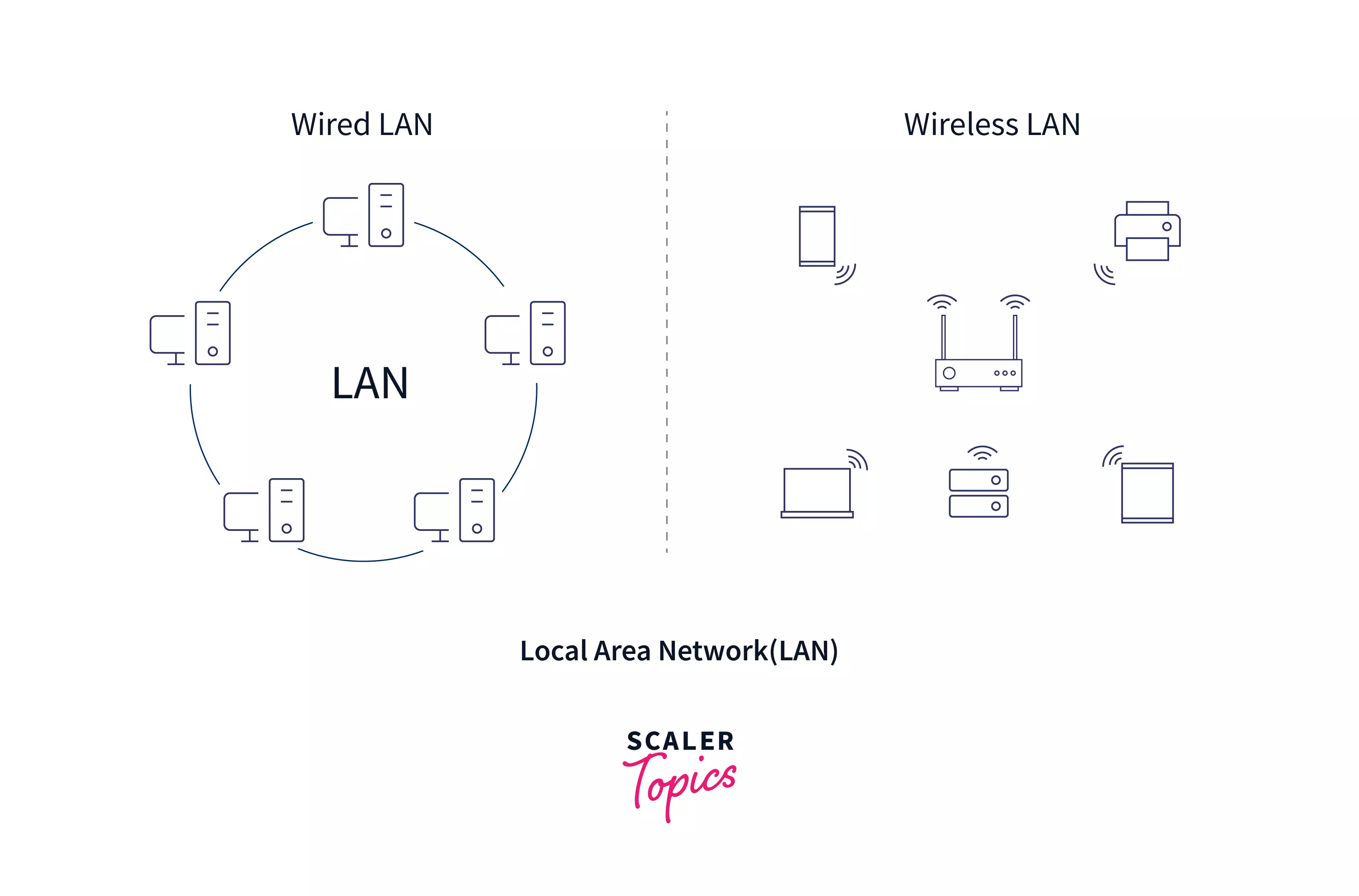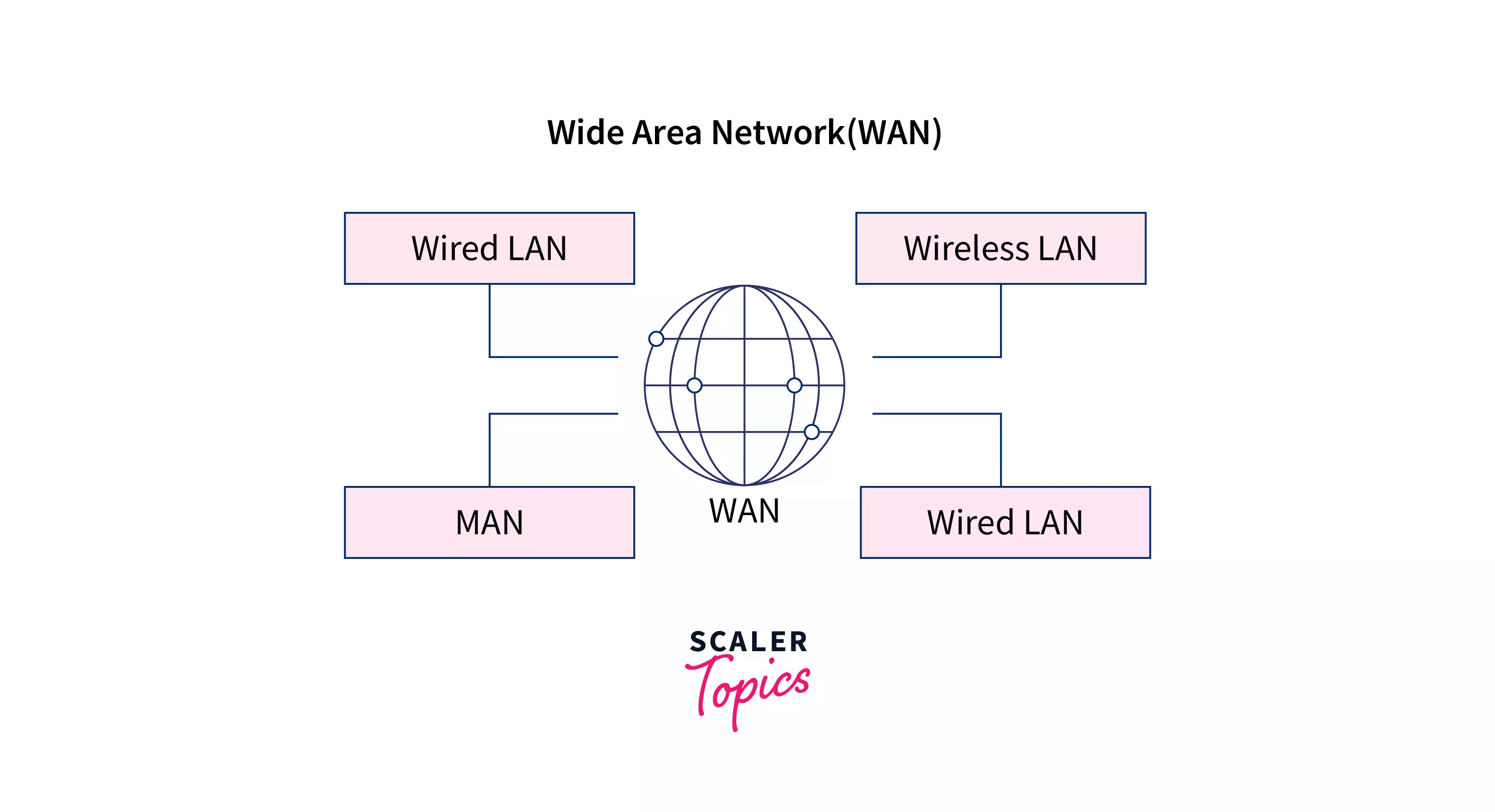Computer Network is the interconnection of multiple devices. Mainly there are three types of computer networks: LAN (Local Area Network), WAN (Wide Area Network), and MAN (Metropolitan Area Network).
LAN is used to connect devices in a small area like a building, office, etc.
MAN covers the devices connected within a town or a city.
WAN covers a large geographical area such as a continent or a country. System Area Network, Home Area Network, and Campus Area Network are some other network types.
Introduction to Computer Network
Computer Network is the interconnection between multiple devices. Computer Network allows to send and receive data and information between different connected devices. Different devices in a network are connected through links.
Refer to the below image to visualize the computer network

Types of Computer Networks
Based on the size of the network, ownership, and distance covered by the network, there are three types of computer networks
- Local Area Network (LAN)
- Metropolitan Area Network (MAN)
- Wide area network (WAN)
Refer to the below image to show the types of computer networks

LAN (Local Area Network)
A Local Area Network (LAN) is a group of connected devices that are in a limited area such as a school, office, building, or home. It is a network mostly used for sharing hardware resources such as printers, files, scanners, etc. If we talk about the simplest LAN network then we will consider a computer and a printer connected in a home as the simplest network. The data transmission speed of the LAN is up to 10 Mbps.
Refer to the below image to show LAN

There are two types of LAN:
Wired LAN– In this type of LAN, wired cables such as twisted pair or coaxial cables are used for the connection and transmission of data.
Wireless LAN– In this type of LAN, devices are connected by wireless cables such as radio, and light waves.
Refer to the below image to show the types of LAN

Characteristics
- LAN is a type of network owned by the private owner
- LAN can be used to connect printers, personal computers, etc.
- LAN Networks can be designed very easily.
- Troubleshooting of LAN networks is easy.
- Data transfer rate of the LAN network is about 10 Gbits/s.
- It is a network which is limited to the local area.
- LAN operates relatively faster than the WAN network.
Advantages
- LAN allows sharing of computer hardware like printers, scanners, etc. which may reduce the cost of buying expensive computer hardware.
- LAN permits to share of a single internet facility among the devices connected to LAN.
- LAN provides high security and fault tolerance capability.
- It allows the transmission of data between people and devices at a high transmission rate.
Disadvantages
- LAN reduces the cost by allowing sharing of computer hardware, but the initial installation cost of LAN is very high.
- Technical and skilled manpower is required for the configuration and installation of the LAN network.
- Due to the sharing of computer resources among the devices, sometimes the operation speed of the network may slow down.
MAN (Metropolitan Area Network)
A Metropolitan Area Network or MAN is a network connecting devices across an entire town, entire city, or any other small region. This is a network larger than LAN but smaller than the WAN. WAN stands for Wide Area Network which is used to connect devices geographically such as across the country or continent. MAN network works between LAN and WAN. MAN can be used to connect multiple LAN networks. When one LAN uses modems, direct digit devices, and any other media types to connect with other LAN, then it covers a large area which is considered a Metropolitan Area Network (MAN).
Refer to the below image to show the MAN

Characteristics
- MAN is a larger network in comparison to LAN.
- MAN network generally covers the towns and cities in a maximum of 50 km range
- MAN is the most used medium in cables and optical fibers.
Advantages
- MAN network connects all the branches of the company that exist in the same city.
- Dual Bus in MAN networks permits bidirectional data transfer concurrently.
- MAN network is considered economical as it allows the sharing of resources among all the branches of the company which are in the city.
WAN (Wide Area Network)
WAN stands for Wide Area Network is a type of computer network which can cover a large geographical area such as a continent, or a country. The size of the WAN network is larger than the LAN and MAN network. When the size of the network grows more than the MAN then it is considered a WAN. Usually, telecommunication networks are considered a Wide Area Network. WAN Network could be an interconnection between two or more LANs that are connected through telephone lines or radio waves.
Refer to the below image to show the WAN

Characteristics
- WAN is used to cover a large geographical area, like a country.
- WAN can be used to connect within the world and around the world.
- Any office and organization can use WAN to form its global integrated network.
Advantages
- WAN allows covering a large geographical area.
- Offices situated at longer distances from each other can easily communicate through WAN.
- Allows connecting devices like mobile phones, laptops, tablets, etc.
Disadvantages
- There are more chances of error and issues because of the use of more technologies and wide coverage.
- Provides less security in comparison to other types of networks.
- The initial and configuration cost of WAN is very high.
- Skilled technicians and network administrators are required for the setup of this network.
Other Types of Computer Networks
- WLAN (Wireless Local Area Network)
- Storage Area Network
- System Area Network
- Home Area Network
- POLAN- Passive Optical LAN
- Enterprise private network
- Campus Area Network
- Virtual Area Network
1) WLAN WLAN stands for Wireless Local Area Network. WLAN allows one to connect single or multiple devices in a limited area like schools, homes, offices, etc. using a wireless connection. It allows for the transmission of data among the connected devices within the local coverage area. WLAN can be private or public according to the requirement of the user.
2) Storage-Area Network (SAN) A Storage Area Network is a type of network that allows consolidated, block-level data storage. It is mainly used to make storage devices, like disk arrays, optical jukeboxes, and tape libraries.
3) System-Area Network System Area Network is a network that is used for the local network. It provides a high-speed connection facility in processor-to-processor and server-to-server applications.
4) Passive Optical Local Area Network Passive Optical Local Area Network (POLAN) is considered an alternative to the traditional switch-based ethernet. This network helps the user to integrate into structured cabling. It is a network designed to overcome the concerns related to supporting Ethernet protocols and network applications.
5) Home Area Network (HAN): Home Area Network (HAN) is used to establish the connection between two or more computers within a home. It allows the building of a Local Area Network within the home. HAN allows the sharing of printers, files, programs, etc. within the home. This network is useful when there is more than one computer in a home.
6) Enterprise Private Network: Enterprise private networks (EPN) are networks that are owned and built by businesses that wish to share different computer resources by securely connecting different locations.
7) Campus Area Network (CAN): A Campus Area Network is a network that is established by the interconnecting LAN of a specific geographical area. For example, there is a university campus that is linked with other campus buildings. So in this type of situation, CAN is used to connect all academic departments.
8) Virtual Private Network: A Virtual Private Network abbreviated as VPN is a private network that allows connecting remote sites and users by using the public network.VPN provides us with an option to create a protected network connection using public networks.
Difference between LAN vs MAN vs WAN
Now let us understand the difference between different types of computer networks
| LAN | MAN | WAN |
|---|---|---|
| LAN stands for Local Area Network | MAN stands for Metropolitan Area Network | WAN stands for Wide Area Network. |
| Speed of LAN network is very high | Speed of MAN network is average | Speed of WAN network is low in comparison of LAN |
| Private organizations own the LAN network | Ownership of the MAN network can be public or private. | Ownership of the WAN network can be public or private. |
| LAN has a low maintenance cost. | MAN has maintenance cost more than LAN | Maintenance cost of WAN is more than both LAN and WAN. |
| Congestion is less in LAN. | Congestion is more than LAN. | Congestion is more than both LAN and MAN. |
| LAN covers small areas such as the same office or building. | MAN covers a large area such as a city or town. | WAN can cover a large geographical area such as country, continent, etc. |
Conclusion
- Computer network connect multiple devices via links and allows the transmission of data and information between different connected devices.
- Based on the size, and distance covered by the network there are three types of computer networks i.e. LAN, WAN, and MAN.
- LAN (Local Area Network) is generally used to connect devices of a limited area such as a building, home, office, etc.
- MAN (Metropolitan Area Network) is used to connect the devices among the city, a town, or any other small area.
- WAN (Wide Area Network) is a type of network that covers a large geographical area.
- WLAN (Wireless Local Area Network), Storage Area Network, System Area Network, Home Area Network, POLAN- Passive Optical LAN, Enterprise private network, Campus Area Network, and Virtual Area Network are other types of computer networks.